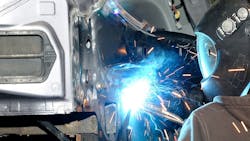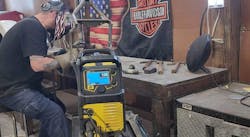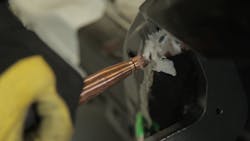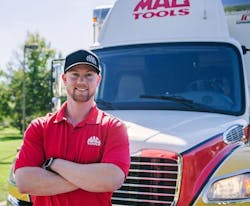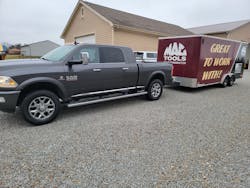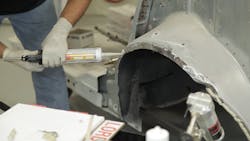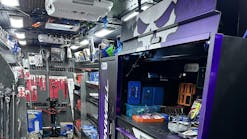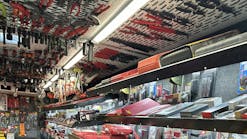Selling welding and collision tools to body shops
Today's collision repair facility is not like the traditional body shop from 30 years ago. It has evolved significantly along with the complexities of vehicles that manufacturers are producing today.
Welding equipment has also greatly improved in recent years to where they are easier for inexperienced techs to operate and still adjustable enough for the more seasoned ones. But there's a caveat, not all body panel repairs use the same type of welding processes. It depends on the manufacturer's requirements.
“Most body shops traditionally use MIG,” says Jason Mahugh, director of engineering and technical services at Forney, which makes welding machines and plasma cutters for automotive shops, specifically body shops.
“Occasionally, body shops will TIG-weld, but it takes more skill, and it’s a bit slower. I don't see a lot of TIG in body shops. It’s mostly multi-process (MP) machines, which are about the same price as a dedicated MIG welder. So a lot of customers prefer an MP machine instead of a dedicated MIG just for the value and versatility.”
The Forney Industries 220 MP Multi-Process Welder, No. 410, features a high welding capacity of 1/2” and 220A of welding power, making it ideal for use on steel, stainless steel, cast iron, and aluminum (with spool gun). It offers dual-voltage (120V/240V) input power.Forney
Welding Equipment
Mahugh says they offer a wide variety of welders and plasma cutters designed for automotive uses from MIG to TIG and MP machines that can be operated in three modes (MIG, TIG and Arc). But most body shops don’t stick-weld unless they do general repair as well. Stick welding is not as precise but can handle very thick material.
“We develop welding machines and plasma cutters for thicknesses of around a half inch and thinner. So that kind of covers your typical automotive application. In terms of amperage for plasma cutting, we have a 20-amp plasma cutter, which is a quarter-inch machine, a 30-amp plasma cutter, which is a three-eighths machine, and a 40-amp plasma cutter, which is a 1/2” machine,” says Mahugh, who notes that these are popular in body shops because they are easy to use and fast for cutting off panels.
There are several options when it comes to amperages in an MP welder, according to Mahugh. But much depends on the type of power your customer’s shop needs or has available. Lower amperage machines will not weld as thick of material as higher amperages but will only require a 120V circuit, whereas a more versatile machine, such as Forney’s newly launched 190 MP, can run on both 120 and 240 volts.
“Our 140-amp works for 1/4” material, and the 190-amp multi-process machine can weld up to 3/8. And then we have other machines that cover 1/2”. So we cover the whole gamut,” notes Mahugh
While most body shops use MIG machines (whether a dedicated or an MP), in the past, there were some downsides to using a dedicated MIG machine, mainly because the technology made them more difficult for the beginning welder. And they were much more expensive and heavier. But today, that is changing with new technology, allowing for easier manufacturing processes and more affordable options along with lighter weight.
“Twenty years ago, almost everyone used the dedicated MIG machine, and they were based on a transformer-style power supply. It was expensive and challenging to make a multi-process machine. But now that most welding machines are based on PCBs (printed circuit boards), it's much easier to make a multi-process machine with modern technology. It used to be that if you wanted to change from MIG welding to stick welding or TIG welding, it was challenging. It might take a technician five or 10 minutes to change over. It takes about 30 seconds to change from MIG welding to TIG welding. Technology has changed a lot in recent years. And so I would say nowadays, there are not a lot of downsides. We intentionally design our machines for quick changeover between processes and very simple controls, just for that reason, so it's easy to change.”
With the changing technology comes lighter weight and more options from a manufacturing standpoint, so many body shops are opting for the MP machines today. Mahugh points out that while most techs use MIG for collision work, some of these body shops also work on weekend projects, such as a motorcycle or go-kart on the side. “The shop owner or tech may want to use TIG for the Chromoly tubing on his go-kart or something like that, or maybe even has a race car with a cage that needs to be welded. So that's where the value of the multi-process machine can come into play.”
An MP machine can also stick-weld, but that is not a process used very often in automotive shops anymore unless it’s for frame work or some sort of trailer accessory with very thick metal. Still, it’s a good option to have when the need arises.
Aluminum Repair
One of the advantages to using a MIG machine or process is that you can weld steel and aluminum without much difficulty or training (especially with newer machines that are more automated for the correct amperages and wire feed speeds. More on that later).
“Normally, when you [weld aluminum] you use a spool gun that attaches to your MIG machine,” says Mahugh. “And that allows you to feed the soft aluminum wire a short distance, which is a problem with MIG welding aluminum. The wire is so soft it's hard to feed 15 feet. So a spool gun with a small one or two-pound spool of wire on the gun only pushes the wire maybe eight to 12 inches. It’s much easier to push a rope 8 to 12” than it is to push a rope 10 or 15’. That's the concept with aluminum spool welding.”
More independent body shops are welding and repairing aluminum than ever today, so Maghugh says it can be a benefit to have a MIG machine that is set up to do both steel and aluminum with little fuss.
“One of our machines (the 242 MIG) is set up where you can run steel out of the machine, but then you can also have an aluminum spool gun hooked up, and all you have to do is flip a switch. So, one minute you're welding steel, and the next minute, you're welding aluminum with just the flip of a switch. There are things like that we try to accommodate because a lot of body shops are doing aluminum repair now. I almost never saw a body shop do aluminum ten years ago. Now, quite a few body shops are doing aluminum, particularly with the Ford F150, and some of the European cars use a fair bit of aluminum as well.”
Some body shops may even want to set up a separate MIG welding station for aluminum just to keep them apart because some of the hammers and tools also need to be separated due to the risk of corrosion and cross-contamination.
Spot Welding
On the other end of the spectrum, more body shops, especially dealership body shops, are using high-end spot-welding machines that can give the perfect spot weld every time. One of the drawbacks of using a MIG machine to weld body panels is it comes down to the ability of the technician to properly perform multiple plug and spot welds over the course of the repair.
Squeeze-type resistance spot welders (STRSW) are the latest evolution of spot-welding machines that will hold the panel in place and apply the perfect amount of force for the electrode to bond, depending on the type of material used by the OEMs. With this process, panels are squeezed together with a specific amount of pressure while the weld is created. Tips of resistance spot welders are made of copper, which is a better conductor of electricity than steel. These machines more closely mimic the OEM construction and introduce less heat into the weld, which reduces the chance of corrosion. Also, many OEMs today use advanced steel alloys that are even thinner than in previous years when mild cold-rolled steel was more common.
According to I-CAR instructor and ABRN (a PD sister publication) contributor David Brinkley, STRSW is the best way to join “advanced steels” currently used by many OEMs. Some OEMs require using STRSW machines such as Pro Spot and others, whether it’s for general collision repair or specific body repair procedures. “Many of these advanced steels do not respond well to methods of the past. Even though advanced steel may appear satisfactorily joined after MIG/MAG welding, the amount of heat introduced into the area could have caused that steel to become brittle and not perform well in a subsequent collision. If corrosion sets in due to the coatings being damaged, that can also affect crashworthiness.”
Pre- and Post-Scan
Jason Pennington, a Mac Tools dealer in Dayton, Ohio, covers four routes in his territory now with four other drivers while he pulls a diagnostic trailer around with specialty tools. The trailer is equipped with tools such as scanners and larger shop equipment like an A/C recovery machine, transmission jack, and engine hoist, to name a few. It allows Pennington to go wherever he’s needed to make a sale whenever one of his mobile truck drivers gives him a lead.
Pennington says he sells collision tools to many body shops in his area, including a few welders like the ESAB 210, which he says is so easy to use that it practically sells itself. However, he mainly focuses on selling diagnostic tools to body shops because he sees it as an increasing opportunity for his business.
“More body shops need scanners today to do pre- and post-scans before and after a repair job,” he says. “And the insurance companies pay per scan, so a shop could make $200 just to do a health check and ensure no major codes popup.”
While Pennington stays busy pulling his diagnostics trailer and selling big ticket items like MIG welders and multi-purpose machines that both MIG and TIG weld, he says his mobile route drivers handle more of the tool sales that collision shops need, such as Vise Grips (for body panels), specialty clamps and clip tools (Lisle), media blast wheels, and angle grinders. Those are the most popular items for body shops.
Consumables
Jay Sicht, who is the managing editor of ABRN and Motor Age, says that selling collision shops consumables such as sanding discs, cutters, drill bits, and so forth, could be a challenge for mobile tool dealers, depending on the area because many shops get deliveries every day, sometimes multiple times per day, from their paint supplier that sells some of these products as well. He says the tool needs of body shops are very different than general repair shops and that visiting once a week may not be enough for their consumable needs.
Pennington agrees: “Body shops and general automotive repair shops are very different animals in terms of tool sales.” While some general repair shops may buy a welder and even a few whiz wheels, they don’t use them as often as a collision shop does. He says they have done well selling certain consumables to body shops because he typically has better quality products than the paint supplier, and he stocks them on the truck for whenever they need it.
Today’s collision shop has changed significantly over the last decade, or more, due to the increased complexity of vehicles shops deal with day in and day out, according to Sicht. “Today’s high-strength sheet steel is thinner and stronger, and there’s more aluminum that shops have to be able to repair.”
Epoxy Bonding and STRSW
Furthermore, OEMs often require a specific epoxy bonding agent be applied to the panel before the welding process, so plug-welding will compromise the integrity of the weld, as well as the sealing from the bond. Consequently, more OEMs are requiring a specialized spot welder to make these repairs. Sicht says that shops are starting to transition to the newer squeeze-type resistance spot welders because they can be set for the manufacturer's requirements, and they make a perfect weld every time, regardless of skill level.
While STRSW machines are quite expensive, Pennington notes that he’s had good luck selling multi-purpose ESAB units because many techs are not necessarily skilled welders and can use this type of equipment with little or no welding experience. “You don't need to know the settings and look up specs in a book; you can just kind of set the dial to the material you’re welding and thickness, and the machine does the rest.”
For aluminum repairs, most MIG welders can weld aluminum by changing to a spool gun, but aluminum dent repair is another area of growth, according to Pennington. “We are getting a lot of shops now asking about tools for handling aluminum repairs. Many of these vehicles are now older and out of warranty which would typically be handled by a dealership collision center. Now, they're going into more independent body shops.”
But what Pennington mostly focuses on is selling diagnostics to the body shops because they need pre- and post-scans. “I know some body shops are getting $60-$100 a scan per vehicle on a pre-scan. Then [the shop] makes that same amount again on a post-scan and can email the report to the front office, which sends it directly to the insurance company.”
The health reports are more for protection against any comebacks when you do a post-scan, according to Pennington. It shows the insurance company and customer there were no DTCs after the repair. He says that body shops are not using basic code readers anymore because they don’t catch everything. “You need a bi-directional tool that can read all of the modules (i.e., body modules), and shops must update it regularly for access to all of the manufacturers.” He says the subscriptions can run about $50 a year per manufacturer, but it is worth it for the peace of mind.
